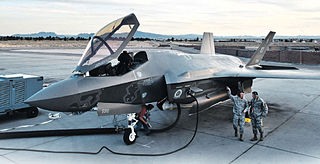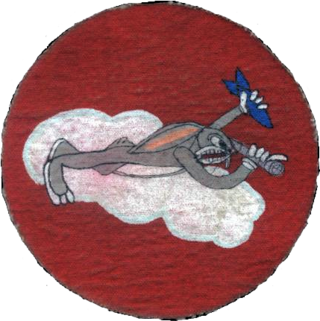
Barksdale Air Force Base is a United States Air Force (USAF) base in Bossier Parish, Louisiana in northwest Louisiana. It is contiguous to Bossier City, Louisiana, along the base's western and northwestern edge. Barksdale AFB occupies more than 22,000 acres (89 km2) east of Bossier City and along the southern edge of Interstate 20. More than 15,000 active-duty and Air Force Reserve Command (AFRC) members serve at Barksdale.

Mather Air Force Base was a United States Air Force Base, which was closed in 1993 pursuant to a post-Cold War BRAC decision. It was located 12 miles (19 km) east of Sacramento, on the south side of U.S. Route 50 in Sacramento County, California. Mather Field was one of 32 Air Service training camps established after the United States entry into World War I in April 1917.

Aerospace Defense Command was a major command of the United States Air Force, responsible for air defense of the continental United States. It was activated in 1968 and disbanded in 1980. Its predecessor, Air Defense Command, was established in 1946, briefly inactivated in 1950, reactivated in 1951, and then redesignated Aerospace rather than Air in 1968. Its mission was to provide air defense of the Continental United States (CONUS). It directly controlled all active measures, and was tasked to coordinate all passive means of air defense.

The 99th Air Base Wing is a United States Air Force unit assigned to the Air Combat Command (ACC) and its ACC subordinate organization, the United States Air Force Warfare Center. It is based at Nellis Air Force Base, Nevada and also serves as the host wing at Nellis.

The 1st Combat Evaluation Group was a Strategic Air Command (SAC) unit. It was formed on 1 August 1961 to merge the 3908th Strategic Standardization Group for SAC aircrew evaluation with the 1st Radar Bomb Scoring Group that had originated from the 263rd Army Air Force Base Unit which transferred from 15th AF to directly under Strategic Air Command c. 1946. The 1CEVG formed after SAC switched to low-level tactics to counter Soviet surface-to-air missiles and SAC had "developed a Radar Bomb Scoring field kit for use in NIKE Systems" in early 1960 for scoring SAC training missions against US Hercules SAM sites. The 1CEVG headquarters included an Office of History and a "standardization and evaluation school" for command examiners.

The 413th Flight Test Group is a United States Air Force Air Force Reserve Command unit. It is stationed at Robins Air Force Base, Georgia as a tenant unit.

Bangor Air National Guard Base is a United States Air National Guard base located on the grounds of Bangor International Airport in Bangor, Maine.

The Reeves AN/MSQ-77 Bomb Directing Central, Radar was a USAF automatic tracking radar/computer system for command guidance of military aircraft during Vietnam War bomb runs at nighttime and during bad weather. Developed from the Reeves AN/MSQ-35, the AN/MSQ-77 reversed the process of Radar Bomb Scoring by continually estimating the bomb impact point before bomb release with a vacuum tube ballistic computer. Unlike "Course Directing Centrals" which guided aircraft to a predetermined release point, the AN/MSQ-77 algorithm continuously predicted bomb impact points during the radar track while the AN/MSQ-77's control commands adjusted the aircraft course. A close air support regulation prohibited AN/MSQ-77 Combat Skyspot bombing within 1,000 yd (910 m) of friendly forces unless authorized by a Forward Air Controller, and "on several occasions" strikes were as close as 273 yd (250 m).
Cheli Air Force Station, formerly located within Bell in southeastern Los Angeles County, California, was a United States Air Force installation and a Cold War Radar Bomb Scoring site of the Strategic Air Command, from 1947 to 1961.

A Bombardier School was a United States Army Air Forces facility that used bombing ranges for training aircrew. After ground simulator training with the Norden bombsight, the 12- to 18-week course recorded each student's scores for approximately 160 practice bomb drops of "Bomb Dummy Units" (BDU), both in daytime and at night. The elimination rate was 12%, and graduates transferred to a Second or Third Air Force training unit to join a crew being trained for overseas duty. The bombardier trainer used was the Beech AT-11 Kansan. With the Bradley Plan increase in Eighth Air Force aircrews needed for the Combined Bomber Offensive, the 17 Army Air Forces Bombardier Schools graduated 47,236.
Radar Bomb Scoring is a combat aviation ground support operation used to evaluate Cold War aircrews' effectiveness with simulated unguided bomb drops near radar stations of the United States Navy, the USAF Strategic Air Command, and Army Project Nike units. USAF RBS used various ground radar, computers, and other electronic equipment such as jammers to disrupt operations of the bomber's radar navigator, AAA/SAM simulators to require countermeasures from the bomber, and Radar Bomb Scoring Centrals for estimating accuracy of simulated bombings. Scores for accuracy and electronic warfare effectiveness were transmitted from radar sites such as those at Strategic Range Training Complexes.
RBS Express railroad trains were 3 mobile United States Air Force radar stations for 1CEVG Radar Bomb Scoring (RBS) of Strategic Air Command bomber crews beginning in March 1961. Electronic equipment included the "MSQ-39, TLQ-11, MPS-9, and the IFF/SIF for the MSQ-39" along with support railcars, and the trains were temporarily used at various rail sites with the radar antennas emplaced using hoists built onto flatcars. Pulled by a "contracted locomotive" that left the train at the site, and a North American B-25 Mitchell was used for calibration of the radar station.

The Badlands Bombing Range (BBR) refers to Rapid City Army Air Base target ranges for World War II which included the current Air Force Retained Area, an inactive 2,486-acre (10.06 km2) United States Air Force site "20 miles southeast" of Scenic, South Dakota. The retained area is the remainder of 341,726 acres (1,382.92 km2) federally acquired in 1942 under eminent domain at the Pine Ridge Indian Reservation. In addition to use by World War II aircraft, BBR was used for a post-war Army National Guard gunnery range and a Cold War Radar Bomb Scoring site.
The AN/MPQ-2 Close Cooperation Control Unit was a truck-mounted post-World War II automatic tracking radar/computer/communication system for aircraft command guidance, e.g., missile tracking, and for Radar Bomb Scoring. For ground directed bombing (GDB), an operator would manually plot a target on the "Blind Bombing Plotting Sheet", then use the manual "E6B computer and bombing tables" to plot the release point for striking the target, after which a radar operator used the MPQ to acquire a track of the bomber near an initial point during which allowed ground control of the bomb run to the release point.
The Stockton Ordance Depot was a World War II vehicle repair facility, supply depot, and camp for German and Italian prisoners of war. The installation was also used as a USAF radar station and a DLA Defense Distribution Center.
The 3903rd Radar Bomb Scoring Group was a military evaluation unit under direct command of Strategic Air Command (SAC) headquarters for scoring simulated bomb runs using automatic tracking radar stations. Initially an Army Air Forces Base Unit (AAFBU) and then a squadron, the 3903rd RBS Group was personnel, assets, and detachments were redesignated the 1st Radar Bomb Scoring Group and then the 1CEVG Radar Bomb Scoring Division when the RBS Group merged with the 3908th Strategic Standardization Group in 1961, the year RBS Express trains began to be used for low-altitude Boeing B-52 Stratofortress operations..
The Louis Blotner Radar Site was a tracking site site in Connor, Maine at the former NIKE missile launch site. Activated in June 1963 and operational until after 1979, The Ashland site was an AUTOTRACK radar site operated by Detachment 7 of the 1st Combat Evaluation Group. The station simulated Electronic Countermeasures and Radar Bomb Scoring for the Ashland Training Range's low-level training route "over Bangor north to Houlton, Maine.
McClellan Air Force Base Annex #1 was a military installation near McClellan Air Force Base in Sacramento County, California, that was active from 28 November 1951 to 2 July 1956. Strategic Air Command operated an automatic tracking radar station just outside the base at Whitney and Eastern Avenues.
Ashland Radar Station was a United States Air Force station located in Ashland, Maine operational from around 1975 to 1990. Sitting on 6.59 acres (2.67 ha).












